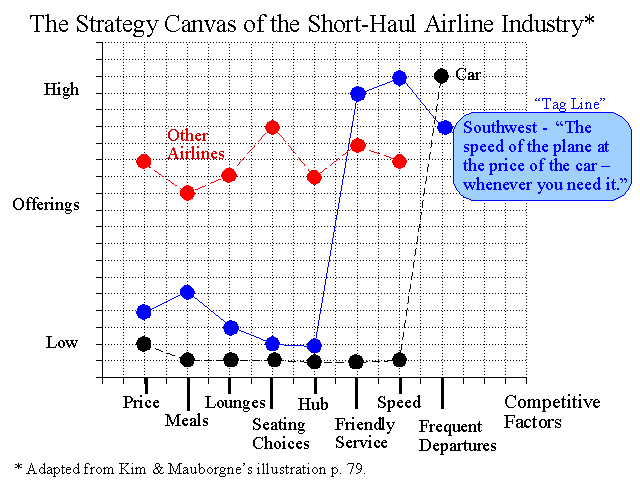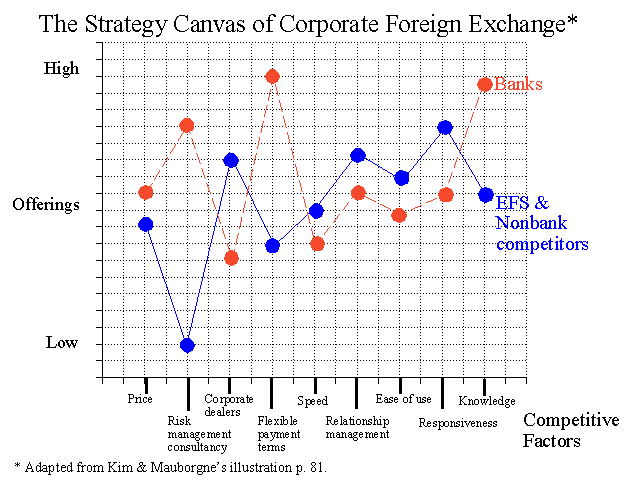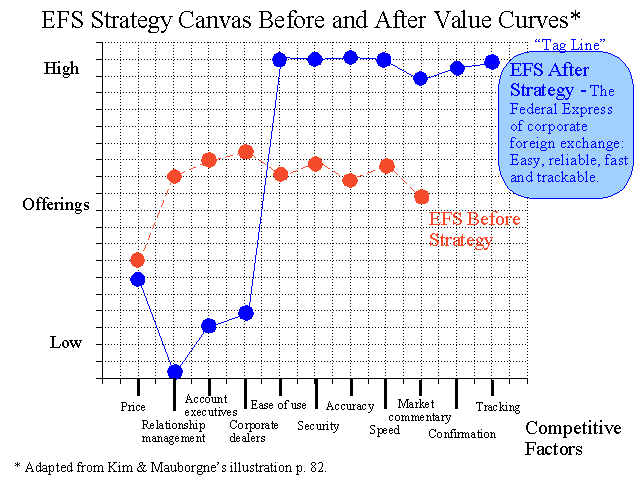
Summary by Neil Escalante
Master of Accountancy Program
University of South Florida, Summer 2003
Balanced Scorecard Main Page |
Strategy Related Main Page
This article is mainly a blueprint for making a visual chart of a company’s strategy. The authors believe that seeing a visual chart is vital for easy communication of strategic plans and company goals. This chart is known as a strategy canvas.
Drawing strategy canvases achieves three main objectives. First, it displays the present and tries to predict future factors that affect competition in an industry thereby showing the industry’s strategic profile. Second, it presents the strategic factors that are present and that potential competitors invest in, thus giving their strategic profile. And finally, it illustrates the company’s strategic profile (also known as the value curve) by showing which factors of competition the company invests in currently and possibly in the future. This value curve is the basic component of the strategy canvas.
The graphic below illustrates the strategy canvas of the short-haul airline industry and Southwest Airline’s unique strategy within the industry.

The authors believe that a good strategy has three qualities:
Focus,
Divergence, and
A compelling tag line.
Every strategy must have a focus. This should be easily identifiable when looking at a value curve. In the example above, it is plain to see that Southwest Airline puts more emphasis on service, speed and frequent departures than its competitors. While other things like meals, lounges, and seating options are offered at a bare minimum. Looking at the value curve also reveals the divergence of the company’s strategy. While other airlines have similar strategies, Southwest has become a pioneer by providing faster and more frequent flights. In fact, the revolutionary strategy of not investing in meals and seating options has allowed Southwest to set the price of its tickets way below the industry standard. A compelling tag line is evidence of a strong strategy. The article defines the Southwest tag line as “The speed of the plane at the price of the car – whenever you need it.” Clearly this reflects the company’s strategy of speed, convenience and price. Their competitors cannot offer any tag line that would demonstrate a unique strategy.
The authors continue to provide considerable detail on how to go about drawing a strategy canvas. They describe how one company, under the pseudonym European Financial Services (EFS), brought together more than 20 of its senior managers from all over the world and had them produce value curves for the company’s traditional form of business as well as their online business. According to the account, it was very difficult for the executives to determine their current corporate strategy. Also, it was hard to establish what changes needed to be made to keep the company competitive.
Kim and Mauborgne indicate that there are four steps involved in visualizing strategy:
Visual awakening,
Visual exploration,
Visual strategy fair, and
Visual communication.
The purpose of the first part of the EFS story was to bring about the concept of Visual Awakening. The idea is that you need to be able to recognize your current strategy. This should be compared to what you perceive your competitors’ strategies to be. These should be charted and compared to see if any apparent changes need to be made. This step produced two strategy canvases that revealed defects in the company's strategy. An adaptation of one of these illustrations appears below.

The second stage in visualizing a strategy is Visual Exploration. This stage requires some field work to study customers’ wants, needs, preferences and methods of transacting with the company. Direct observation of customers may be required to get a full understanding of these factors. Feedback is also vital for understanding if the strategy is working and how to perfect it. In addition, the company needs to develop some awareness of the benefits of alternatives that customers may prefer. EFS actually sent its managers into the field for four weeks to observe ten people who were involved in corporate foreign exchange to determine whether they used EFS or some alternative. This research yielded some interesting results. EFS realized that some aspects of its strategy (e.g., relationship management) were not important to their customers while some things that were never implemented (such as instant confirmations of transactions) could greatly increase customer satisfaction and efficiency.
The third stage is a Visual Strategy Fair. This stage is a lot like brainstorming. New ideas are pushed out. Many new value curves are drawn expressing a wide variety of choices for a new company strategy. These new ideas are exposed to current customers, lost customers, competitors’ customers, and in some cases even employees and management. Feedback is collected to determine the optimal new strategy or to develop an optimal one if further changes are to be made.
An adaptation of EFS before and after value curves developed at the end of this step are presented in the illustration below. Their tag line became, "The Federal Express of corporate foreign exchange: Easy, reliable, fast and trackable."

The final stage is Visual Communication. In this stage, conveying the new strategy to employees is the goal. The actual point of the entire article is to stress the importance of visual aids in deciding what the current corporate strategy is and depicting that idea to the individuals in the company. The article suggests that the best method of communicating a new strategy is by distributing before-and-after strategic profiles on one page for easy comparison. This makes it easier to see which new projects to support in the course of business (i.e., those that help the company move from the old to the new strategy).
It is clear that visualizing what exactly must be done to improve a business and its strategy would prove to be an asset. Of course things are easier to see when there is a picture right in front of you. This article provides an action plan for developing a better visualization of the big picture behind the company’s strategy. This is something that may not be obvious at first. The authors conclude, though, by saying that documentation and actual numbers and statistics are needed when establishing a strategy. Charts are not complete without them.
__________________________________________
Related Summaries:
Anthony, R. N. 1964. Framework for analysis. Management Services (March-April): 18-24. (Summary).
Chenhall, R. H. and K. Langfield-Smith. 1998. The relationship between strategic priorities, management techniques and management accounting: An empirical investigation using a systems approach. Accounting, Organizations and Society 23(3): 243-264. (Summary).
Christensen, C. M. 1997. Making strategy: Learning by doing. Harvard Business Review (November-December): 141-142, 144, 146, 148, 150-154, 156. (Summary).
De Geus, A. 1999. The living company. Harvard Business Review (March-April): 51-59. (Summary).
Gadiesh, O. and J. L. Gilbert. 2001. Transforming corner-office strategy into frontline action. Harvard Business Review (May): 72-79. (Summary). (Gadiesh and Gilbert define a strategic principle as an actionable statement about a company's strategy. This is essentially what Kim and Mauborgne refer to as a tag line).
Hammer, M. 2001. The superefficient company. Harvard Business Review (September): 82-91. (Summary).
Iansiti, M. and R. Levien. 2004. Strategy as ecology. Harvard Business Review (March): 68-78. (Summary).
Kaplan, R. S. and D. P. Norton. 2001. The Strategy-Focused Organization: How Balanced Scorecard Companies Thrive in the New Business Environment. Boston, MA: Harvard Business School Press. (Summary).
Kim, W. C. and R. Mauborgne. 1997. Value innovation: The strategic logic of high growth. Harvard Business Review (January-February): 103-112. (Summary).
Kim, W. C. and R. Mauborgne. 1999. Creating new market space: A systematic approach to value innovation can help companies break free from the competitive pack. Harvard Business Review (January-February): 83-93. (Summary).
Kim, W. C. and R. Mauborgne. 2004. Blue ocean strategy. Harvard Business Review (October): 76-84. (Summary).
Kim, W. C. and R. Mauborgne. 2004. Value innovation: The strategic logic of high growth. Harvard Business Review (July/August): 172-180. (Reprint of their 1997 HBR article). (Summary).
Kim, W. C. and R. Mauborgne. 2009. How strategy shapes structure. Harvard Business Review (September): 72-80. (Summary).
Kim, W. C. and R. Mauborgne. 2015. Red ocean traps: The mental models that undermine market-creating strategies. Harvard Business Review (March): 68-73. (Summary).
Langfield-Smith, K. 1997. Management control systems and strategy: A critical review. Accounting, Organizations and Society 22(2): 207-232. (Summary).
Luehrman, T. A. 1998. Strategy as a portfolio of real options. Harvard Business Review (September-October): 89-99. (Summary).
Magretta, J. 2002. Why business models matter. Harvard Business Review (May): 86-92. Explains the difference between a business model and a competitive strategy. (Summary).
O'Clock, P. and K. Devine. 2003. The role of strategy and culture in the performance evaluation of international strategic business units. Management Accounting Quarterly (Winter): 18-26. (Summary).
O'Reilly, C. A. III. and M. L. Tushman. 2004. The ambidextrous organization. Harvard Business Review (April): 74-81. (Summary).
Porter, M. E. 1980. Competitive Strategy: Techniques for Analyzing Industries and Competitors. The Free Press. (Summary).
Porter, M. E. 1987. From competitive advantage to corporate strategy. Harvard Business Review (May-June): 43-59. (Summary).
Porter, M. E. 1996. What is a strategy? Harvard Business Review (November-December): 61-78. (Summary).
Porter, M. E. 2001. Strategy and the internet. Harvard Business Review (March): 63-78. (Summary).
Reeves, M., C. Love and P. Tillmanns. 2012. Your strategy needs a strategy. Harvard Business Review (September): 76-83. (Note).
Ulrich, D. and N. Smallwood. 2004. Capitalizing on capabilities. Harvard Business Review (June): 119-127. (Summary).